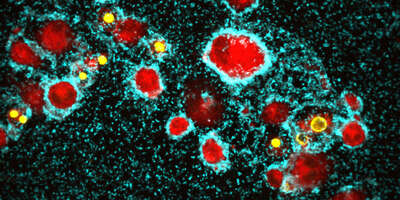Main Content
Research Projects
The lab focuses on understanding multicellular bacterial behaviors, using biofilm formation and swarming as model systems. By combining microscopy, molecular biology techniques, statistics, machine learning, and mathematical modeling, we study how bacteria form complex multicellular communities, how these communities function, and how these communities affect bacterial ecology.
Biofilm dynamics: From growth to dispersal
Which cell-cell interactions determine biofilm architecture? And how do cells decide when they should disperse from biofilms? To understand how biofilms emerge from the interactions of all cells, we developed 3D image analysis techniques which allow us to track all individual cells in biofilms, revealing beautiful internal cellular arrangements, and the different stages of biofilm growth. [Drescher, et al. 2016; Hartmann, et al. 2019; Hartmann, et al. 2021]. We have made these image analysis tools available in the form of a software tool, BiofilmQ [Hartmann, et al. 2021].
These single-cell level data during biofilm development can be used to constrain hypotheses about key cell-cell interaction mechanisms that take place during biofilm growth. We recently found that mechanical interactions are dominant during early biofilm development [Hartmann, et al. 2019]. Also during exposure to high flow rates, mechanical interactions shape biofilm growth, even if high flow rates modulate the mechanical interaction strength [Pearce, et al. 2019]. Biofilm interactions with flow are technologically highly relevant, and we have characterized several interesting phenomena for biofilm behaviors in flow, including the dynamics of streamer formation [Drescher, et al. 2013; Kim, et al. 2014].
In parallel to our work on biofilm development, we are also investigating the development of bacterial swarming. Like biofilms, the microscopic dynamics inside swarms can be explained using mechanical interactions [Jeckel, et al. 2019a; Jeckel, et al. 2019b]
Cells often do not stay in a biofilm forever. Yet it is unclear how cells reach a decision for when they should decide to disperse, and how they disperse. For Vibrio cholerae, we recently discovered that cells monitor a self-secreted quorum sensing signal, and the local nutrient concentration, to reach robust decisions about dispersal as a collective [Singh, et al. 2017].
Biofilms in Ecology and Evolution
Why do bacteria form biofilms? Bacteria that are bound in biofilms are highly resistant against antibiotics and other chemical insults of the environment, which is a clear evolutionary advantage of forming biofilms. Remarkably, the mechanisms underlying the biofilm-antibiotic interaction is poorly understood, and we are investigating unicellular and multicellular responses to antibiotics in biofilms [Diaz-Pascual et al. 2019].
Apart from providing protection against toxins, evolutionary advantages to biofilm formation are vague. However, we recently found the mechanisms underlying the most important selective advantage of making a biofilm: predation avoidance by bacteriophages. [Vidakovic, et al. 2018; Simmons, et al. 2018; Simmons et al. 2019]
We also recently discovered another reason for why bacteria may want to form biofilms: physical aspects of the biofilm life style strongly favor the evolution of simple social behaviors, such as the production of shared resources or "public goods" [Drescher, et al. 2014; Nadell, et al. 2013]. In addition, we are investigation social interactions in spatially structured biofilm communities [Dragos, et al. 2018; Nadell, et al. 2016].
Biophysics of bacterial collective behaviors
What can we learn about collective bacterial behaviors from physics? Many aspects of bacterial interactions are inherently physical. Some examples: During biofilm growth, cells push and pull on each other, while being embedded in an elastic matrix. Understanding the molecular transport of nutrients and metabolites through the biofilm also relies on physics. Before bacteria form biofilms, their swimming motility creates fluid flows that lead to physical interactions with surfaces and other bacteria.
[Jeckel, et al. 2019; Drescher, et al. 2011; Wensink, et al. 2012; Dunkel, et al. 2014]



